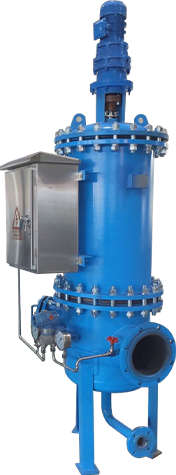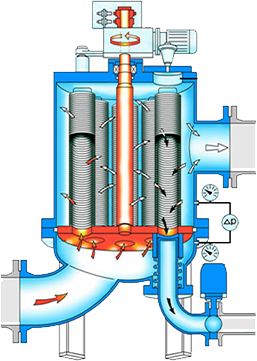Introduction
Ensuring the purity and cleanliness of fluids is crucial in a wide range of industrial and commercial applications. Multi-cartridge self-cleaning filters are advanced filtration systems designed to handle high flow rates and provide continuous filtration without manual intervention. This article offers an in-depth exploration of multi-cartridge self-cleaning filters, including their introduction, working principle, components, technical specifications, and application fields.
Product Introduction
Multi-cartridge self-cleaning filters are sophisticated filtration units that utilize multiple filter cartridges arranged in parallel to enhance filtration efficiency and capacity. These filters are engineered to automatically clean the filter elements without interrupting the filtration process. They are widely used in industries such as petrochemicals, water treatment, food and beverage, pharmaceuticals, and power generation, where maintaining clean fluid systems is vital for operational efficiency and product quality.

Working Principle
The working principle of a multi-cartridge self-cleaning filter involves several stages to ensure effective filtration and self-cleaning:
Filtration: Fluid enters the filter housing through the inlet and flows through the filter cartridges. Each cartridge captures contaminants on its surface, allowing clean fluid to pass through and exit via the outlet.
Accumulation: As filtration continues, contaminants accumulate on the surface of the filter cartridges, creating a layer of debris that can reduce filtration efficiency and increase pressure drop.
Self-Cleaning Activation: When the differential pressure across the filter cartridges reaches a predetermined threshold, indicating the need for cleaning, the self-cleaning cycle is initiated. This can be triggered automatically by the control system based on time intervals or pressure sensors.
Cleaning Process: During the self-cleaning cycle, one or more cartridges are isolated from the flow, and a reverse flow or backwash mechanism is activated. This mechanism uses clean fluid or compressed air to dislodge and remove the accumulated debris from the filter cartridges.
Debris Removal: The dislodged debris is collected and expelled through a drain or waste outlet, while the cleaned cartridges are returned to service. This process ensures continuous filtration without interrupting the fluid flow.
Product Components
Multi-cartridge self-cleaning filters consist of several key components, each contributing to the overall filtration and self-cleaning efficiency:
Filter Housing: The filter housing is a robust casing that encloses all the internal components. It is typically made from durable materials such as stainless steel or carbon steel to withstand high pressures and corrosive environments.
Filter Cartridges: The filter cartridges are the primary filtration elements, available in various materials such as pleated synthetic fibers, stainless steel mesh, or cellulose. The number of cartridges can vary depending on the filter's design and capacity requirements.
Cartridge Holders: These structures securely hold the filter cartridges in place and ensure proper alignment for effective filtration. They are designed to allow easy removal and replacement of cartridges during maintenance.
Cleaning Mechanism: The cleaning mechanism can include backwash nozzles, rotating arms, or other devices that direct the cleaning fluid or air to dislodge debris from the filter cartridges. This mechanism is driven by a motor or pneumatic system.
Control System: The control system monitors the differential pressure across the filter cartridges and manages the self-cleaning cycle. It can be programmed to initiate cleaning based on specific parameters, ensuring optimal performance and minimal manual intervention.
Inlet and Outlet Ports: These ports allow fluid to enter and exit the filter housing. They are designed to accommodate various pipe sizes and connection types, ensuring compatibility with different systems.
Drain and Waste Outlets: These outlets are used to expel the dislodged debris and waste fluid from the filter housing during the self-cleaning cycle. They are typically automated to synchronize with the cleaning process.
Technical Specifications
Understanding the technical specifications of multi-cartridge self-cleaning filters is essential for selecting the right filter for a specific application. Key specifications include:
Filtration Efficiency: This measures the filter's ability to capture particles of different sizes. High-efficiency filters can remove particles as small as a few microns, ensuring superior fluid cleanliness.
Flow Rate: The maximum flow rate indicates the volume of fluid the filter can handle per unit of time. Multi-cartridge filters are designed to accommodate high flow rates, making them suitable for large-scale applications.
Pressure Drop: The pressure drop across the filter measures the resistance to fluid flow. Lower pressure drop is preferred as it reduces energy consumption and maintains efficient system operation.
Cartridge Capacity: The number of cartridges and their individual capacities determine the overall filtration capacity of the filter. More cartridges and higher capacity cartridges allow for longer intervals between cleaning cycles.
Material Compatibility: The materials used in the filter housing, cartridges, and seals must be compatible with the fluid being filtered. This ensures durability and prevents corrosion or degradation.
Operating Pressure and Temperature: The filter must withstand the operating pressure and temperature conditions of the application. Specifications include maximum allowable pressure and temperature ranges.

Application Fields
Multi-cartridge self-cleaning filters are used in a wide range of applications to ensure clean and efficient fluid systems:
Water Treatment: In water treatment plants, these filters remove suspended solids, algae, and other contaminants from raw water, ensuring clean water for municipal and industrial use.
Petrochemicals: In the petrochemical industry, multi-cartridge filters protect equipment and processes by removing particulates from hydrocarbons, solvents, and other fluids.
Food and Beverage: These filters are used to maintain the purity of ingredients and final products, ensuring compliance with strict hygiene and safety standards.
Pharmaceuticals: In pharmaceutical manufacturing, multi-cartridge filters remove contaminants from process fluids, ensuring product quality and preventing contamination.
Power Generation: In power plants, these filters protect turbines, boilers, and cooling systems by removing debris and contaminants from water and other fluids.
Agriculture: In agricultural applications, multi-cartridge filters are used to purify irrigation water, ensuring the health and productivity of crops.
Conclusion
Multi-cartridge self-cleaning filters are essential tools for maintaining clean and efficient fluid systems across various industries. By understanding their working principles, components, technical specifications, and application fields, we can appreciate their vital role in ensuring operational efficiency, product quality, and equipment longevity. Whether in water treatment, petrochemicals, food and beverage, or pharmaceuticals, multi-cartridge self-cleaning filters provide reliable and continuous filtration solutions.
Other Related Products:
High Flow Cartridge Filter
Basket filter
High flow filter element
{sval:sql sql='SELECT n_parameter FROM dede_addonarticle WHERE aid = ~aid~ ' } {/sval:sql}
{sval:sql sql='SELECT n_parameter FROM dede_addonarticle WHERE aid = ~aid~ ' } {/sval:sql}



















